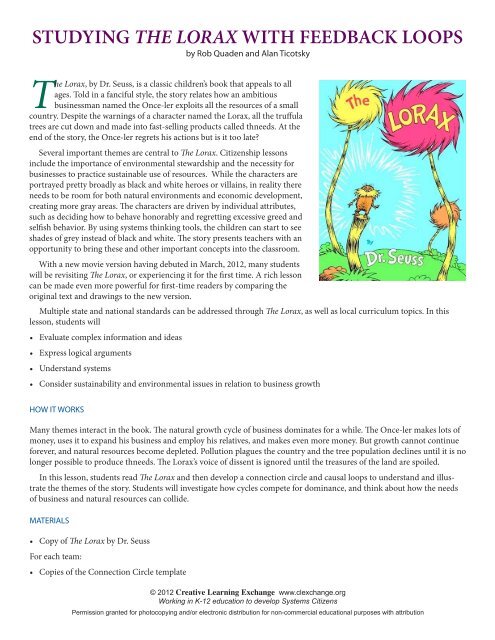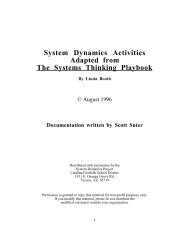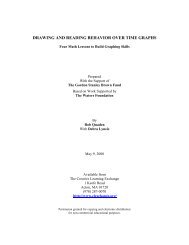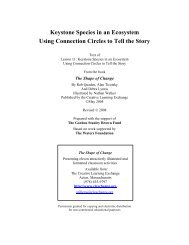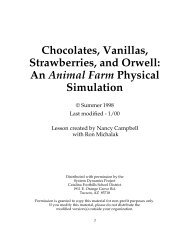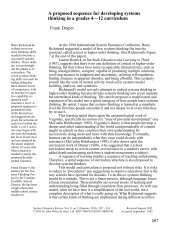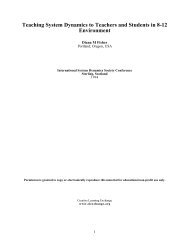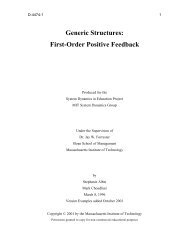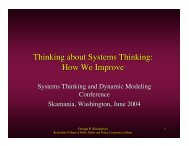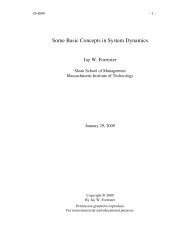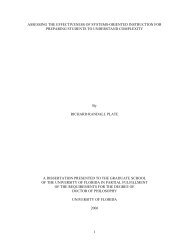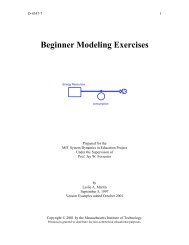studying the lorax with feedback loops - Creative Learning Exchange
studying the lorax with feedback loops - Creative Learning Exchange
studying the lorax with feedback loops - Creative Learning Exchange
Create successful ePaper yourself
Turn your PDF publications into a flip-book with our unique Google optimized e-Paper software.
STUDYING THE LORAX WITH FEEDBACK LOOPSby Rob Quaden and Alan TicotskyThe Lorax, by Dr. Seuss, is a classic children’s book that appeals to allages. Told in a fanciful style, <strong>the</strong> story relates how an ambitiousbusinessman named <strong>the</strong> Once-ler exploits all <strong>the</strong> resources of a smallcountry. Despite <strong>the</strong> warnings of a character named <strong>the</strong> Lorax, all <strong>the</strong> truffulatrees are cut down and made into fast-selling products called thneeds. At <strong>the</strong>end of <strong>the</strong> story, <strong>the</strong> Once-ler regrets his actions but is it too late?Several important <strong>the</strong>mes are central to The Lorax. Citizenship lessonsinclude <strong>the</strong> importance of environmental stewardship and <strong>the</strong> necessity forbusinesses to practice sustainable use of resources. While <strong>the</strong> characters areportrayed pretty broadly as black and white heroes or villains, in reality <strong>the</strong>reneeds to be room for both natural environments and economic development,creating more gray areas. The characters are driven by individual attributes,such as deciding how to behave honorably and regretting excessive greed andselfish behavior. By using systems thinking tools, <strong>the</strong> children can start to seeshades of grey instead of black and white. The story presents teachers <strong>with</strong> anopportunity to bring <strong>the</strong>se and o<strong>the</strong>r important concepts into <strong>the</strong> classroom.With a new movie version having debuted in March, 2012, many studentswill be revisiting The Lorax, or experiencing it for <strong>the</strong> first time. A rich lessoncan be made even more powerful for first-time readers by comparing <strong>the</strong>original text and drawings to <strong>the</strong> new version.Multiple state and national standards can be addressed through The Lorax, as well as local curriculum topics. In thislesson, students will• Evaluate complex information and ideas• Express logical arguments• Understand systems• Consider sustainability and environmental issues in relation to business growthHOW IT WORKSMany <strong>the</strong>mes interact in <strong>the</strong> book. The natural growth cycle of business dominates for a while. The Once-ler makes lots ofmoney, uses it to expand his business and employ his relatives, and makes even more money. But growth cannot continueforever, and natural resources become depleted. Pollution plagues <strong>the</strong> country and <strong>the</strong> tree population declines until it is nolonger possible to produce thneeds. The Lorax’s voice of dissent is ignored until <strong>the</strong> treasures of <strong>the</strong> land are spoiled.In this lesson, students read The Lorax and <strong>the</strong>n develop a connection circle and causal <strong>loops</strong> to understand and illustrate<strong>the</strong> <strong>the</strong>mes of <strong>the</strong> story. Students will investigate how cycles compete for dominance, and think about how <strong>the</strong> needsof business and natural resources can collide.MATERIALS• Copy of The Lorax by Dr. SeussFor each team:• Copies of <strong>the</strong> Connection Circle template© 2012 <strong>Creative</strong> <strong>Learning</strong> <strong>Exchange</strong> www.clexchange.orgWorking in K-12 education to develop Systems CitizensPermission granted for photocopying and/or electronic distribution for non-commercial educational purposes <strong>with</strong> attribution
PROCEDURE1. READ THE STORYThe teacher should decide <strong>the</strong> bestmethod appropriate to his or herclass—read aloud, shared reading, etc.2. PREPARE THE CONNECTIONCIRCLEIf students have never used connectioncircles before, go over <strong>the</strong> rulesfor finding <strong>the</strong> elements of <strong>the</strong> story aslisted on <strong>the</strong> template at <strong>the</strong> end of thislesson plan. Each student can use acopy of <strong>the</strong> template or <strong>the</strong>y can draw<strong>the</strong>ir own circles. We suggest workingin teams to encourage sharing of ideas.(For a full explanation, see The Shapeof Change, by Rob Quaden and AlanTicotsky, <strong>Creative</strong> <strong>Learning</strong> <strong>Exchange</strong>,2004, available on <strong>the</strong> CLE website.)3. CHOOSE THE ELEMENTSWithout too much prompting,students should identify <strong>the</strong> importantelements that change in <strong>the</strong> story.Encourage <strong>the</strong>m to talk in teams whileeach student in <strong>the</strong> team creates his orher own connection circle. Possibleelements include truffula trees,thneeds, pollution, Once-ler’s greed,Once-ler’s profits, <strong>the</strong> Lorax’s anger,factory size, and o<strong>the</strong>r things thatchange quantitatively during <strong>the</strong> story.It may help to bundle <strong>the</strong> animals affected by <strong>the</strong> habitat degradation into oneelement ra<strong>the</strong>r than listing <strong>the</strong>m individually. After students have worked inteams for a short time, lead a whole class session, allowing students to share <strong>the</strong>elements <strong>the</strong>y have chosen. The teacher can build a composite circle on <strong>the</strong>overhead or a chart pad. Each team may have a different interpretation, so <strong>the</strong>circle produced by <strong>the</strong> whole class may have more elements than individual teamcircles. Building connection circles can help represent and clarify divergentthinking.Trees cutProfitsFactory sizeTruffulatreesThe Lorax’sangerOnce-ler’sgreedEnvironmentalqualityThneedsproducedAnimalpopulation“I believe we should givestudents a more effective wayof interpreting <strong>the</strong> worldaround <strong>the</strong>m. They shouldgain a greater and wellfoundedconfidence formanaging <strong>the</strong>ir lives and <strong>the</strong>situations <strong>the</strong>y encounter.”Sample of elements around a connection circleDr. Jay Forrester,1994Page 2
4. Next, ask students to identify anelement around <strong>the</strong> circle that changesquantitatively in <strong>the</strong> story and causesano<strong>the</strong>r element to change. Draw anarrow from <strong>the</strong> cause to <strong>the</strong> effect. Youmay label <strong>the</strong> direction of <strong>the</strong> changeby putting a + or – sign near <strong>the</strong> arrowhead. Use a + sign when <strong>the</strong> change isin <strong>the</strong> same direction and a – signwhen <strong>the</strong> change is in <strong>the</strong> oppositedirection.In <strong>the</strong> example below, <strong>the</strong> link from“Thneeds produced” to “Profits” is +because producing thneeds adds toprofits. The link from “Trees cut” to“Truffula trees” is – because cuttingtrees reduces <strong>the</strong> number of trees.TreescutProfitsFactorysize+Truffula Trees–The Lorax’sangerStudents may be confused at first when using + and – because <strong>the</strong>signs do not always mean more and less. In <strong>the</strong> link between“thneeds produced” and “profits,” when production goes down,profits go down also. That’s still a positive (+) causal relationshipbecause <strong>the</strong> elements move in <strong>the</strong> same direction. When <strong>the</strong> elementsmove in opposite directions, <strong>the</strong> causal relationship is negative (–).A trickier example is births and population. Even when <strong>the</strong> number ofbirths decreases, “births” to “population” is a positive (+) causalrelationship, since any birth increases <strong>the</strong> population. Both elementsmove in <strong>the</strong> same direction.One or two examples should beenough to get students started. Have<strong>the</strong>m work in teams as each studentdraws his or her own connections.EnvironmentalqualityOnce-ler’sgreedSample of elements around a connection circle, <strong>with</strong> a few arrowsfrom cause to effectPage 3ThneedsproducedAnimalpopulation5. After students have had a short timeto work in teams, bring <strong>the</strong> classtoge<strong>the</strong>r to share some of <strong>the</strong> connections.The circles may look cluttered<strong>with</strong> arrows at this point. (See PartialDiagram on next page.) Ask if studentscan trace a path so that <strong>the</strong>y canstart at one element, travel along <strong>the</strong>arrows to at least one o<strong>the</strong>r element,and return to <strong>the</strong> starting point.6. Instruct students to trace over <strong>the</strong>pathways using highlighting pens orcolored pencils.7. Have <strong>the</strong>m copy <strong>the</strong> pathways <strong>the</strong>yhave traced onto a separate page,drawing <strong>the</strong>m as <strong>loops</strong>. Chooserepresentatives to draw <strong>the</strong>se <strong>loops</strong> on<strong>the</strong> board or on overhead transparenciesin order to share <strong>the</strong>m <strong>with</strong> <strong>the</strong>class. Name <strong>the</strong> <strong>loops</strong> for reference.Students should gain insight as <strong>the</strong>ylook at <strong>loops</strong> and find leverage points<strong>with</strong>in <strong>the</strong> story.Elements around <strong>the</strong> circle <strong>with</strong>arrows in only one direction (comingin only or going out only) indicate thatstudents have not identified <strong>feedback</strong><strong>loops</strong> containing that element. Insome cases, <strong>the</strong> element is not centralto <strong>the</strong> story, or <strong>the</strong> informationavailable doesn’t tell us enough tomake ano<strong>the</strong>r connection. Sometimesstudents need to add an element to <strong>the</strong>circle to complete a loop.
Trees Treescut cutFactoryFactorsizey sizeProfitsprofitsOnce‐ler’sgreedTruffulaTruffula trees treesThe Lorax’sLorax’s angerangerTrees cut•Makes student thinking visibleEnvironmental •Helps students make connectionsqualityEnvironmentalquality•Allows students to explore multipleways to solve problemsThneeds Thneeds•Develops reading and writingproduced produced skills•Increases student engagementOnce-ler’sOnce‐ler’s greedgreedPartial Diagram: Sample of elements around a connection circle,<strong>with</strong> many arrows from cause to effect+++Benefits of Systems ThinkingThe examples that follow demonstrateone complete loop and oneAnimal Animalpopulation incomplete loop. The complete looppopulation(below left) tells that as <strong>the</strong> Once-ler’sgreed increased, he cut down moretrees. That led him to increase <strong>the</strong>factory size. More thneeds wereproduced, which increased profits. Asprofits grew, <strong>the</strong> Once-ler’s greed grewas he continued to seek more wealth.This might be named <strong>the</strong> “profits”loop or <strong>the</strong> “greed” loop.StocksOnce <strong>the</strong> important <strong>loops</strong>are identified, it is goodpractice to put a rectanglearound <strong>the</strong> elements andtalk <strong>with</strong> <strong>the</strong> students about<strong>the</strong> fact that <strong>the</strong> elementsin <strong>the</strong> story are stocks.profits+Profits LoopThneedsproduced+FactorysizeElements or units that go upand down, that can accumulateor diminish, are calledstocks. (See Quaden,Ticotskyand Lyneis, “In and OutGame,” from The Shape ofChange, available from <strong>the</strong><strong>Creative</strong> <strong>Learning</strong> <strong>Exchange</strong>website, www.clexchange.org.)Complete LoopPage 4
?Lorax’sangerLorax’sanger--Once‐ler’sgreedOnce‐ler’sgreed+AnimalpopulationIncomplete LoopEnvironmentloopEnvironmentLoop-Animal+population++Trees cutEnvironmentalqualityTrees cut+-Environmentalquality-8. DEALING WITH INCOMPLETELOOPSExamine an incomplete loop <strong>with</strong> <strong>the</strong>students. In <strong>the</strong> example on <strong>the</strong> left,<strong>the</strong> Once-ler’s greed grows, and moretrees are cut down. Environmentalquality decreases, causing a decreasein <strong>the</strong> animal population. As <strong>the</strong>animal population goes down, <strong>the</strong>Lorax’s anger goes up. What does <strong>the</strong>Lorax’s anger cause?Students will probably face thisquestion. Does <strong>the</strong> Lorax’s anger affect<strong>the</strong> o<strong>the</strong>r elements of <strong>the</strong> connectioncircle? Or, to state <strong>the</strong> question from asystems perspective, is <strong>the</strong>re any<strong>feedback</strong> resulting from <strong>the</strong> anger?Some students will contend that <strong>the</strong>Lorax’s anger actually makes <strong>the</strong>Once-ler greedier or at least moredetermined to exploit <strong>the</strong> Truffulatrees. “Business is business” after all.Ano<strong>the</strong>r interpretation is that <strong>the</strong>re isa long delay in <strong>the</strong> story. After <strong>the</strong>environment is destroyed, <strong>the</strong> Oncelerfinally feels regret. The “Lorax’sanger” reduces “Once-ler’s greed” as<strong>the</strong> ruined entrepreneur now understandswhat he has done. That closes<strong>the</strong> loop, making an EnvironmentLoop (lower left) to contrast <strong>with</strong> <strong>the</strong>Profits Loop.Sometimes a new element is neededto close a loop. Students may add afactor that does not appear on <strong>the</strong>irconnection circle. For example,“Once-ler’s regret” may be an elementthat changes during <strong>the</strong> story, causedby <strong>the</strong> Lorax’s behavior or <strong>the</strong> overalldegradation of <strong>the</strong> environment, orboth. Then <strong>the</strong> Once-ler’s regretreduces or eliminates his greed. See<strong>the</strong> Environment Loop on <strong>the</strong> nextpage.Page 5
‐Once‐ler’sgreed+Once‐ler’sregretEnvironmentLoopEnvironmentloopTrees cut+ ‐Lorax’sanger‐Environmentalquality-+Animalpopulation+9. COMBINING THE LOOPSOnce students have developed twoor three <strong>loops</strong>, check to see if anelement is part of more than one loop.Where elements overlap, two <strong>loops</strong>can be combined. Students in one classdeveloped three <strong>loops</strong>.Page 6
The element “Thneed Production” occurs in all three <strong>loops</strong>, so <strong>the</strong> <strong>loops</strong>can be combined:Once <strong>the</strong> <strong>loops</strong> are combined inone diagram, encourage students tostate <strong>the</strong> dynamics of <strong>the</strong> Lorax storyin <strong>the</strong>ir own words. By referring to <strong>the</strong>different <strong>loops</strong> in <strong>the</strong> diagram, studentscan trace how different <strong>loops</strong>dominate at different points in <strong>the</strong>story. Seeing how loop dominancechanges and affects complex systems isan important technique.10. SUMMING UPUse this lesson plan as an example,and expect that students will havediffering opinions about The Lorax, as<strong>the</strong>y will about any complex issue.Encourage students to use <strong>the</strong> connectioncircle tool to find <strong>feedback</strong> <strong>loops</strong>that will help explain and illustrate<strong>the</strong>ir arguments.Stories and issues often hinge onconflicting <strong>loops</strong>. Dominance among<strong>loops</strong> may change and affect <strong>the</strong> story,as it does in The Lorax. The ProfitsLoop, <strong>the</strong> Production Loop, and <strong>the</strong>Lorax’s Environment Loop are allconnected. Students will see that <strong>the</strong><strong>loops</strong> contain some elements incommon. Wherever humans build,<strong>the</strong>se <strong>loops</strong> will come into play. While<strong>the</strong>re are no easy solutions, understanding<strong>the</strong> <strong>feedback</strong> <strong>loops</strong> helps usunderstand <strong>the</strong> situation and makemore informed decisions.© 2012 <strong>Creative</strong> <strong>Learning</strong> <strong>Exchange</strong> www.clexchange.orgWorking in K-12 education to develop Systems CitizensPermission granted for photocopying and/or electronic distribution for non-commercial educational purposes <strong>with</strong> attributionThe image of a book cover is on page 1 and <strong>the</strong> copyright for it is most likely owned ei<strong>the</strong>r by <strong>the</strong> artist who created <strong>the</strong> cover or <strong>the</strong> publisher of <strong>the</strong>book. It is believed that <strong>the</strong> use of low-resolution images of book covers to illustrate an article discussing <strong>the</strong> book in question qualifies as fair use underUnited States copyright law. O<strong>the</strong>r use of this image might be copyright infringement.Page 7
NAME __________________________CONNECTION CIRCLESRules1. Draw a large circle.2. List important elements around <strong>the</strong> circle.A. Restrict <strong>the</strong> number to between five and ten.B. All elements should be nouns or noun phrases.C. Elements can increase or decrease.3. Identify an element that causes ano<strong>the</strong>r element to increase or decrease.A. Draw an arrow from <strong>the</strong> cause to <strong>the</strong> effect.B. Make sure that <strong>the</strong> causal connection is a direct one.C. Identify polarity of arrow and label <strong>with</strong> a + or a - near <strong>the</strong> arrow head.4. Continue to identify elements <strong>with</strong> causal connections.
Connection to Characteristics of Complex Systems ProjectLesson Titles:Lessons from The Lorax: Using Graphs to Study ChangeStudying The Lorax <strong>with</strong> Feedback LoopsOverview:These two lessons on Dr. Seuss’s classic children’s book, The Lorax, provide a rich opportunityto students to learn environmental stewardship and why businesses must practice sustainable useof resources.Related Characteristic(s) of Complex Systems:• Conflicts arise between short-term and long-term goals.• Cause and effect are not closely related in time or space.Ideas and Examples for Connecting to <strong>the</strong> Characteristic:Individuals or groups may use resources to meet short-term goals at <strong>the</strong> expense of sustainingthose resources over <strong>the</strong> long-term. In The Lorax, a business run by <strong>the</strong> Once-ler depletes <strong>the</strong>truffula trees to make products called thneeds.Ask students questions such as, “What is <strong>the</strong> Once-ler likely to do if demand increases?” “Whatshould <strong>the</strong> Once-ler do to ensure sustainability into <strong>the</strong> future?” “How many thneeds can bemade when all <strong>the</strong> truffula trees are gone?” “What happens to <strong>the</strong> population <strong>with</strong>out thneeds?”An archetype, such as <strong>the</strong> Tragedy of <strong>the</strong> Commons, can illustrate how using a resource fasterthan it can regenerate leads to <strong>the</strong> loss of that resource. If <strong>the</strong> short-term goal is to harvest asmuch of <strong>the</strong> resource as possible, <strong>the</strong>n <strong>the</strong> resource will decline (and possibly run out) in <strong>the</strong>long-term.© 2013 <strong>Creative</strong> <strong>Learning</strong> <strong>Exchange</strong> www.clexchange.orgWorking in K-12 education to develop Systems CitizensPermission granted for photocopying and/or electronic distribution for non-commercial educational purposes <strong>with</strong> attribution
+Group A treeharvestRNet Gains-A+++BTotal harvest+B-Gain perharvest+Resource limitGroup B treeharvest+R++Net Gains-BFigure: Example of Tragedy of <strong>the</strong> CommonsA stock/flow diagram shows how <strong>the</strong> system has long delays. Once <strong>the</strong> damage is recognized(<strong>the</strong> resource is depleted), <strong>the</strong> problem cannot be fixed immediately; regeneration of trees cantake generations. When cause and effect are separated by time, it can be difficult to link <strong>the</strong> twotoge<strong>the</strong>r and see <strong>the</strong>m as parts of a single system.SeedsSproutingSproutsGrowingSaplingsMaturingMatureTreesHarvestingTime to sproutTime to growTime to matureFigure: Stock/Flow diagram <strong>with</strong> time delaysResource(s)O<strong>the</strong>r ideas for teaching The Lorax in <strong>the</strong> classroom:http://www.seussville.com/Educators/<strong>lorax</strong>_classroom/educator<strong>lorax</strong>_plan.php“Road Maps 4—A Guide to <strong>Learning</strong> System Dynamics”http://clexchange.org/ftp/documents/Roadmaps/RM4/D-4504-7.pdf© 2013 <strong>Creative</strong> <strong>Learning</strong> <strong>Exchange</strong> www.clexchange.orgWorking in K-12 education to develop Systems CitizensPermission granted for photocopying and/or electronic distribution for non-commercial educational purposes <strong>with</strong> attribution


